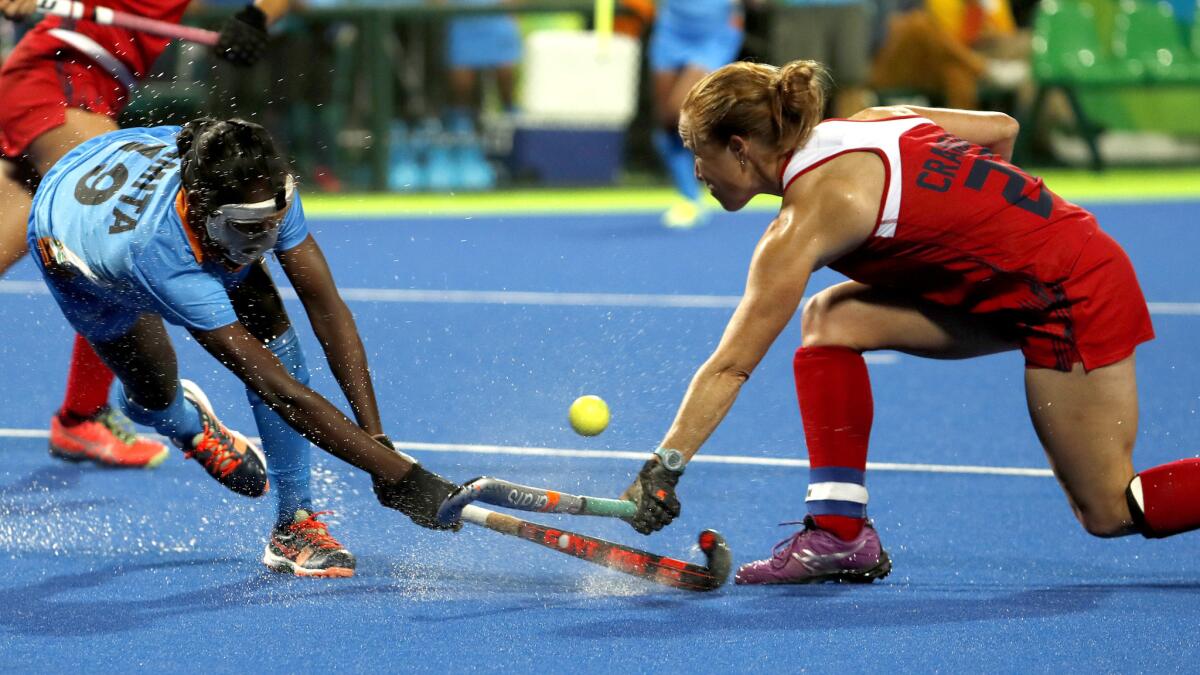Column: There’s no ice, but winning is still nice for the U.S. Olympic women’s field hockey team

Go cover a hockey game, my editor said.
OK, boss. Gladly. From the long list of Olympic sports that we generally see only every four years, he plucked the one I’m most familiar with. Good thing my Professional Hockey Writers’ Assn. card is tucked into my wallet.
So I get on a bus that’s as cold as Winnipeg in January — the better to get in that hockey mood, no doubt — and about 25 minutes later, there’s the sign: Olympic Hockey Centre. Found it.
Wait.
No rink. No skates. Illuminated by floodlights is a cobalt-blue synthetic field open to the chilly night air in Deodoro, where two women’s teams are running up and down the 100-yard-by-60-yard field wearing skirts and carrying sticks about half the size of those used by NHL players.
What gives?
It was hockey, as the rest of the world calls it, while we in North America — who reserve that name for the skates-and-puck game — call it field hockey. There are enough differences to appreciate each sport and enough similarities for anyone accustomed to one version to quickly grasp the major points of the other and enjoy it.
“I always say it’s a mix between ice hockey and soccer, is how I describe field hockey,” said defender Lauren Crandall, captain of the surging U.S. women’s Rio field hockey team.
“I think ice hockey fans would love it,” said forward Katie Bam, who scored two goals Thursday in Team USA’s 3-0 victory over India, the team’s fourth consecutive win. “It’s really fast-paced and there’s a lot of skill involved, like in ice hockey. Constant movement, like in ice hockey. I like ice hockey.”
There are 11 players on the field for each team including a goalie, though few NHL goaltenders likely would wear the shocking pink pads that Jaclyn Briggs wore Thursday. Like the ice version, teams change on the fly. Penalties of two minutes or five minutes are signaled by green or yellow cards, but there’s no penalty box for the player to sit in and feel shame, as in the iconic movie “Slap Shot.” In international competition games consist of four 15-minute quarters and they go quickly without TV timeouts.
Video review is permitted, and it’s as tedious to sit through as it is in every other sport that has it. One key difference: field hockey players must shoot right-handed. Bring that to the NHL and coaches would no longer obsess over forming lefty-right defense pairings.
“I think that hockey is a unique sport. It’s fast, it’s quick, it’s got pace, it’s got action,” midfielder Katelyn Falgowski said. “And yes, swinging sticks around like hockey is enjoyable.”
The U.S. women, whose skill and high-tempo game make their matches entertaining, have been the surprise of the Rio Olympic field hockey tournament. Ranked No. 5 in the world — the highest in program history — they upset No. 2 Argentina and No. 3 Australia before defeating Japan, 6-1, and India. They’ve clinched a spot in the quarterfinals and can finish first in their pool with a victory Saturday over Britain, which also won its first four games.
This is all new because the U.S. has never been a women’s field hockey power. Only one U.S. team has won an Olympic medal, a bronze at the 1984 Los Angeles Games. The program was in a decline and hit bottom four years ago when the women finished last among 12 teams in London, prompting changes that included the appointment of former Britain coach Craig Parnham as head coach in 2013.
They built unity by designating a central training spot in Lancaster County, Pa., at the delightfully named Spooky Nook Sports Complex. About half the players are from Pennsylvania; several others are from New Jersey and Delaware.
“We have nine returning players from 2012 and to have that experience is really important,” Crandall said, “but 3½ years ago we started defining a culture and developing a family. It’s that work we’ve done stepping on the field and the work we’ve done off the field to define ourselves, what we want to be, who we want to be, what we want to look like, what we want to project.”
They’re projecting an aura of confidence and success. Bam, who described herself as a Philadelphia Flyers fan but is adopting the Boston Bruins because she and her husband will be assistant coaches of the Harvard women’s field hockey team, is surprised at the team’s impressive start.
“I didn’t really come in with any expectations, just a goal to play well,” she said. “To be achieving that is really nice for us. I would say I’m slightly surprised, but I’m very, very happy. I didn’t come in writing a script. I wanted it to write itself.”
And so it is. The big prize here isn’t the Stanley Cup, but an Olympic medal would be pretty impressive too.
helene.elliott@latimes.com
Twitter: @helenenothelen
More to Read
Go beyond the scoreboard
Get the latest on L.A.'s teams in the daily Sports Report newsletter.
You may occasionally receive promotional content from the Los Angeles Times.





